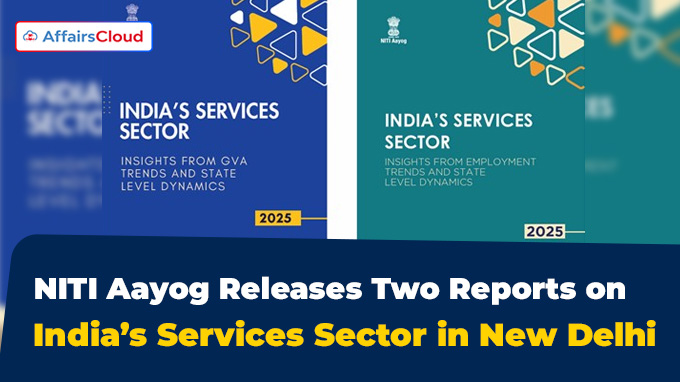In October 2025, B.V.R. Subrahmanyam, Chief Executive Officer (CEO) of National Institution for Transforming India (NITI Aayog) released two reports under the Services Thematic Series, during an event held in New Delhi, Delhi.
- These reports were released in the presence of Dr. Arvind Virmani, Member of NITI Aayog; and Dr. V. Anantha Nageswaran, Chief Economic Adviser (CEA), Government of India (GoI).
Exam Hints:
- What? Release of two inaugural reports on India’s Services Sector
- Released by: B.V.R. Subrahmanyam, CEO of NITI Aayog
- Contribution of Services in GVA: 55% (2024-25)
- Total Workers Employed in Services: 188 million (2023-24)
- Services Share in Employment: from 26.9% (2011-12) to 29.7% (2023-24)
- Region-wise Share: 60.8% (urban areas) and 18.9% (rural areas)
About the Reports:
1st Report: The 1st report titled ‘India’s Services Sector: Insights from GVA Trends and State-Level Dynamics’, provides a comprehensive analysis of the contribution of various sub-categories of services in the economy at national and state level.
- The report showed that the services sector contributed nearly 55% of national Gross Value Added (GVA) in 2024-25, up from 51% in 2013-14.
2nd Report: It is titled ‘India’s Services Sector: Insights from Employment trends and State-level Dynamics’, examines service sector employment to present a multidimensional profile of India’s services workforce across sub-sectors, gender, regions, education, and occupations.
- The report stated that while the services sector drives India’s job growth and post-COVID recovery, issues like uneven employment and informality persist.
- It suggested a four-part roadmap focused on worker formalisation, skill development, green economy investment, and balanced regional growth.
Key Findings:
Total Employment in 2023-24: The reports showed that the services sector employed approximately 188 million workers (nearly 30% of India’s national workforce), adding close to 40 million jobs over the last 6 years.
- Among all States in India, Uttar Pradesh (UP) had the largest number of workers engaged in services sector (i.e. 22.1 million in 2023-24), despite a relatively low share of 22.7%.
Employment Generation: As per both reports, the share of services sector in employment generation has increased from 26.9% (2011-12) to 29.7% (2023-24).
- The report further highlighted that the share of services sector has increased by only 89 basis points (bps) in last 30 years i.e. from 22.1% (in 1992) to 31.0% (in 2022).
- Despite this growth, India’s services share in employment generation still lags behind the global average of nearly 50%.
Structural Divide: The report noted a ‘deep structural divide’ in employment generation, for instance: for high-value segments like: Information Technology (IT), finance, healthcare, and professional services are globally competitive and productivity-rich but employ relatively less people.
- In contrast to it, traditional services like trade and transport continue to dominate the employment in this sector but remain plagued by high informality and limited wage growth, which make these services as ‘hotspots of informal work’
Urban-Rural Divide: The report revealed that the share of services in rural employment declined from 19.9% (2017-18) to 18.9% (2023-24).
- While, the share of services in urban employment has increased from 59.1% to 60.8% over the same time period.
Gender Gap: Between 2017-18 and 2023-24, the participation of male in services has increased from 32.8% to 34.9%. In contrast to it, female participation decreased from 25.2% to 20.1%.
- As per the reports, around 61% of men are employed in services in urban while 60% of urban women in this sector.
- The report observed that rural women remain largely excluded from this sector, accounting just 10.5% of its workforce, which is less than half the share of rural men (24%).
- The report further highlighted that rural services show the widest gender gap as women earn less than 50% of men’s wages (which is the lowest parity across sectors).
- While, in urban services, women earn only 84% of men’s wages.
Informal Employment Distribution: In 2023-24, self-employed own-account workers within the services sector, alone account the largest share (55.7%) of informal workers; followed by regular wage or salaried workers without social protection (29%); helpers in household enterprises (9.2%); and casual labour (6.1%).
Service-Oriented Economies: The reports showed that Chandigarh (77.9%) continues to be the most service-oriented economy in India; followed by Delhi (71.0%); Puducherry (59.6%) and Goa (59.1%).
Age Barrier: The report noted that youth aged between 15 and 29 years is underrepresented, indicating barriers to entry into regular wage work, insufficient skilling, poor job readiness, and weak school-to-work transitions.
- It further revealed that share of older workers (aged above 45 years), has declined sharply, with regular jobs decreasing from 10% (in 55-59 age group) to just 1% (above the age of 65 years).
Gross Employment Elasticity: It is an indicator used to measure job growth responsiveness, increased from 0.35 (pre-COVID19 pandemic) to 0.63 (post-COVID 19 Pandemic).
About National Institution for Transforming India (NITI Aayog):
Vice-Chairperson-Suman Bery
Headquarters- New Delhi, Delhi
Established in- 2015





